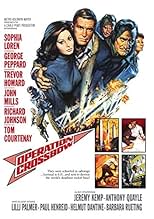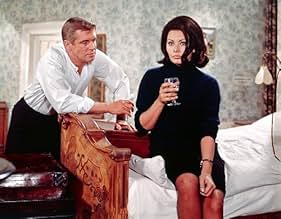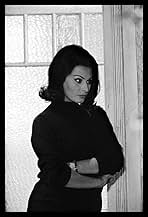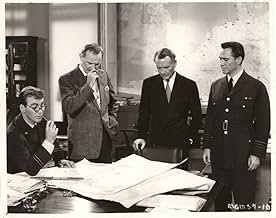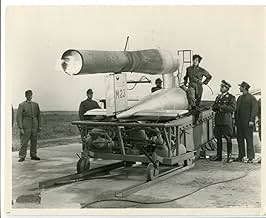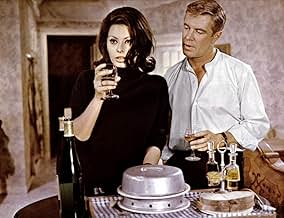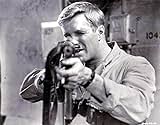IMDb रेटिंग
6.6/10
5.9 हज़ार
आपकी रेटिंग
अपनी भाषा में प्लॉट जोड़ेंAllied agents attempt to infiltrate a German rocket research site.Allied agents attempt to infiltrate a German rocket research site.Allied agents attempt to infiltrate a German rocket research site.
- पुरस्कार
- कुल 1 जीत
Barbara Rütting
- Hannah Reitsch
- (as Barbara Rueting)
फ़ीचर्ड समीक्षाएं
Excellent suspense movie. This one probably "disappeared among the "Guns of Navarone" imitators during the 60's. A pity, since it is worth having a look at. Some points in its favour: "Unpredictable" - characters who usually don't die in movies like this dies unexpectedly and in unexpected order (it doesn't follow the clichés). The spies sent on undercover missions into Germany are actually forced to speak German, and various ruses to cover up the accents have to be made. One negative aside though. At times it seems that two movies are being shown at the same time, a docu-drama about the actual bombings of England and a totally fictitious (albeit exciting) spy drama.
In the annals of Allied history is one of the most secret and certainly most desperate covert attempts to destroy the Nazi's ultimate weapons. These weapons were called the Vengeance Rockets which nearly destroyed England and it willingness to survive. This story written by Duilio Coleitto and directed by Michael Anderson is comparatively close to the actual facts. The conclusion in England was that the V-1 and V-2 were wreaking havoc on London and the prime Minister (Patrick Wymark) called on his war ministry to design a plan to destroy them. Innically, the secret operation was called 'Operation Bodyline' but changed for the movie under " Operation Crossbow." The idea was to select allied officers, trained and educated as engineers, fly them to Germany, have them infiltrate the German War Machine and sabotage the entire V-rocket plant. What they did not harp on was that is was also considered a suicide mission. George Peppard, Tom Courtenay and Jeremy Kemp play the incredibly courageous allied agents who must carry out the task. Anthony Quayle is superb as the traitorous English/German counter agent who's job it is to stop them. Richard Todd, Paul Henreid, Trevor Howard, John Mills, Richard Johnson and Sophia Loren round out the cast. The movie is incredible with actual WWII footage and surprisingly great dramatic acting. The introduction of Sophia Loren within the actual story is puzzling, but interesting. A very good WWII action movie considered a Classic by many movie fans. ****
"Operation Crossbow" is a fictional movie based on historical events of World War II. It's a historical look at Hitler's program to develop rocket weapons and the Allied efforts to foil the Germans. The plot has enough intrigue and action to make the film entertaining. And, the bombing scenes keep the sense of urgency about the race between the Allies and the Germans the last two years that would determine the war's outcome.
The film has a cast of notable movie stars of the day; but I think only a couple stand out for their performances. Trevor Howard is excellent as Professor Lindemann, and Tom Courtenay is very good and convincing as Robert Henshaw.
The real pluses for this film are four. First, it's a reasonable portrayal of historical events and some key people of the time. Second, it has excellent camera work. Third, it has very good recreations of the German rockets and testing sites and of the bombing scenes in London and the air raids on the German sites. Fourth, it uses some actual war film footage sparingly.
During World War II, Operation Crossbow was the code name for the overall Allied effort to destroy the German rocket and long-range bombing projects. It began in early 1943, under the code name "Bodyline," when Allied planes photographed a V-2 rocket site in northern France. The code name changed that fall.
Some of the film characters are based on real people and use their names. Others are amalgams of people. The roles of the main stars aren't real people. Besides Winston Churchill, other British leaders portrayed were real. Richard Johnson plays Duncan Sandys who was in charge of Operation Crossbow. He had been wounded while fighting with British forces in Norway after Germany invaded that country in early 1940. He also was Churchill's son-in-law at the time.
In this movie, Sandys often is at odds with the chief science adviser to his group, Professor Lindemann. Frederick Lindemann was a real person and the chief science adviser to the British war effort. He was a close friend of Winston Churchill and made significant contributions to the Allied war efforts. But, he believed that the German rocket program was a hoax. Another leading scientific adviser was Reginald V. Jones with whom Sandys often clashed. It seems that the film writers combined the two British scientists under the character of Lindemann.
Constance Babington Smith, played by Sylvia Syms, was another very real person in the film. She was the British photo interpreter who first spotted a German rocket site from aerial photos. Another real character was Hanna Reitsch, played by Barbara Rutting. Reitsch was a renowned German aviatrix who set many flying records. She was a test pilot for the Nazis and was the only woman to receive the Iron Cross first class. She survived the war and set many glider records. Reitsch died at age 67 in August, 1979, at Frankfurt – then, West Germany.
MGM's British film group did an excellent job recreating the German Peenemünde rocket research and testing site. The filming was done along the Norfolk coast, NNE of London. Its North Sea location and coastline probably very closely resembled the real German site along the Baltic Sea.
Watching this film again, I understood how the British early on were concerned about Germany's advances in weapons. After the war, and through the 1950s, there was a general sense in the U.S. – and perhaps much of the world – that the Germans were generally superior in the fields of science and engineering. I grew up with that notion. My dad had served in the Army in Europe during WW II, and I later served in the Army in Germany during the Cold War. The Germans continued to excel in cameras, tape recorders, other electronic production and automobiles. But, with the passage of time and greater public awareness of recent history, we now know more about the seeming German prowess in the sciences.
In fact, most of technology and development of the German rocket program had been pioneered almost two decades before by an American scientist, Robert H. Goddard (1882-1945). Today, Goddard is recognized as the father of modern rocketry and the father of the space age. How ironic that when he died in 1945, many still doubted and dismissed him and his work. Yet, he had launched the world's first liquid-fueled rocket in March 1926; and he and his team had launched 34 rockets from then until 1941. He was working with grant monies and obtained more than 200 patents. But much of his work took place during the depression. And, no one – the U.S. government included, seemed interested in all the possibilities that Goddard had envisioned from rocket science and achievements.
My DVD of "Operation Crossbow" had a 10-minute short special with it, "A Look Back at Crossbow." It has some early film clips of Goddard's first attempts to launch rockets. One can see these today on YouTube. This short documentary noted that Germany collected all of the Goddard research achievements for a mere 10 cents per copy from the U.S. Patent Office. And, Adolf Hitler had his Nazi regime embark on a huge R&D program for weapons superiority shortly after he came to power in 1932. The rest is history.
Another American also had much to do with Japan's recovery after the war. W. Edwards Deming was a scientist whose work Japanese industry took seriously. In just two decades, Japan grew to become a world power based on its high quality and innovative production. Japan's industry created the Deming Prize in 1951. President Reagan awarded Deming the National Medal of Technology in 1987. But, just as with Robert Goddard, Deming's work wasn't widely recognized in the U.S. until after his death in 1993. And, that's another whole story.
The film has a cast of notable movie stars of the day; but I think only a couple stand out for their performances. Trevor Howard is excellent as Professor Lindemann, and Tom Courtenay is very good and convincing as Robert Henshaw.
The real pluses for this film are four. First, it's a reasonable portrayal of historical events and some key people of the time. Second, it has excellent camera work. Third, it has very good recreations of the German rockets and testing sites and of the bombing scenes in London and the air raids on the German sites. Fourth, it uses some actual war film footage sparingly.
During World War II, Operation Crossbow was the code name for the overall Allied effort to destroy the German rocket and long-range bombing projects. It began in early 1943, under the code name "Bodyline," when Allied planes photographed a V-2 rocket site in northern France. The code name changed that fall.
Some of the film characters are based on real people and use their names. Others are amalgams of people. The roles of the main stars aren't real people. Besides Winston Churchill, other British leaders portrayed were real. Richard Johnson plays Duncan Sandys who was in charge of Operation Crossbow. He had been wounded while fighting with British forces in Norway after Germany invaded that country in early 1940. He also was Churchill's son-in-law at the time.
In this movie, Sandys often is at odds with the chief science adviser to his group, Professor Lindemann. Frederick Lindemann was a real person and the chief science adviser to the British war effort. He was a close friend of Winston Churchill and made significant contributions to the Allied war efforts. But, he believed that the German rocket program was a hoax. Another leading scientific adviser was Reginald V. Jones with whom Sandys often clashed. It seems that the film writers combined the two British scientists under the character of Lindemann.
Constance Babington Smith, played by Sylvia Syms, was another very real person in the film. She was the British photo interpreter who first spotted a German rocket site from aerial photos. Another real character was Hanna Reitsch, played by Barbara Rutting. Reitsch was a renowned German aviatrix who set many flying records. She was a test pilot for the Nazis and was the only woman to receive the Iron Cross first class. She survived the war and set many glider records. Reitsch died at age 67 in August, 1979, at Frankfurt – then, West Germany.
MGM's British film group did an excellent job recreating the German Peenemünde rocket research and testing site. The filming was done along the Norfolk coast, NNE of London. Its North Sea location and coastline probably very closely resembled the real German site along the Baltic Sea.
Watching this film again, I understood how the British early on were concerned about Germany's advances in weapons. After the war, and through the 1950s, there was a general sense in the U.S. – and perhaps much of the world – that the Germans were generally superior in the fields of science and engineering. I grew up with that notion. My dad had served in the Army in Europe during WW II, and I later served in the Army in Germany during the Cold War. The Germans continued to excel in cameras, tape recorders, other electronic production and automobiles. But, with the passage of time and greater public awareness of recent history, we now know more about the seeming German prowess in the sciences.
In fact, most of technology and development of the German rocket program had been pioneered almost two decades before by an American scientist, Robert H. Goddard (1882-1945). Today, Goddard is recognized as the father of modern rocketry and the father of the space age. How ironic that when he died in 1945, many still doubted and dismissed him and his work. Yet, he had launched the world's first liquid-fueled rocket in March 1926; and he and his team had launched 34 rockets from then until 1941. He was working with grant monies and obtained more than 200 patents. But much of his work took place during the depression. And, no one – the U.S. government included, seemed interested in all the possibilities that Goddard had envisioned from rocket science and achievements.
My DVD of "Operation Crossbow" had a 10-minute short special with it, "A Look Back at Crossbow." It has some early film clips of Goddard's first attempts to launch rockets. One can see these today on YouTube. This short documentary noted that Germany collected all of the Goddard research achievements for a mere 10 cents per copy from the U.S. Patent Office. And, Adolf Hitler had his Nazi regime embark on a huge R&D program for weapons superiority shortly after he came to power in 1932. The rest is history.
Another American also had much to do with Japan's recovery after the war. W. Edwards Deming was a scientist whose work Japanese industry took seriously. In just two decades, Japan grew to become a world power based on its high quality and innovative production. Japan's industry created the Deming Prize in 1951. President Reagan awarded Deming the National Medal of Technology in 1987. But, just as with Robert Goddard, Deming's work wasn't widely recognized in the U.S. until after his death in 1993. And, that's another whole story.
Masterpiece WW 2 film.Excellent production and attention to detail.Good spy story with great cinematography and cast performances.Good visuals on the German V-1/V-2 efforts.Not too much Holywood watering down of storyline.Nice short performance by Loren.One of the top 50 best WW 2 movies ever.One of the top 250 best movies ever.Only for WW 2 spy movie fans who don't mind seeing London get blasted a bit and for big fans of the lead actors......
In some ways an old-fashioned, star-studded, overstuffed "mission" movie, "Operation Crossbow" has, to me, an authentic WWII feeling to it. I'm guessing this movie's scenes and attitudes may have resonated with people in 1965 who'd lived through that period.
World War II was Big, and that's reflected here. The movie's individual characters are less important than the group war effort, something they're very aware of. And the nothing-personal killing of one character by a Resistance member, is pretty stunning. My hat is off to that.
Side note: During the '60s did Thomas Pynchon ("Gravity's Rainbow") go see this movie? He was then working on his big novel about the V-2 rocket. People have noodled about a possible cause-and-effect between movie and novel, including Dave Kehr in the NYTimes. FWIW, somewhere in "Gravity" I think there's a description of someone's wristwatch being worn on the inside of the wrist, "World War II style." (So the luminous hands wouldn't show during night operations??) That's the way George Peppard wears his watch.
World War II was Big, and that's reflected here. The movie's individual characters are less important than the group war effort, something they're very aware of. And the nothing-personal killing of one character by a Resistance member, is pretty stunning. My hat is off to that.
Side note: During the '60s did Thomas Pynchon ("Gravity's Rainbow") go see this movie? He was then working on his big novel about the V-2 rocket. People have noodled about a possible cause-and-effect between movie and novel, including Dave Kehr in the NYTimes. FWIW, somewhere in "Gravity" I think there's a description of someone's wristwatch being worn on the inside of the wrist, "World War II style." (So the luminous hands wouldn't show during night operations??) That's the way George Peppard wears his watch.
क्या आपको पता है
- ट्रिवियाHannah Reitsch (Barbara Rütting) was a real-life person. Reitsch was a German aviatrix, and at one time, Adolf Hitler's personal pilot. During the Battle of Berlin, Reitsch attempted to persuade Hitler to escape from the city in a small lightweight Fieseler Storch airplane.
- गूफ़Although piloted V-1s were built, they were launched from aircraft, not ramps. None were ever used in combat. Hanna Reitsch flew one to establish why other pilots crashed them on landing. She found that the problem was caused by the aircraft's exceptionally high stall speed.
- भाव
Phil Bradley: The first rocket I built rose three feet into the ground. The second took off horizontally, went straight through a hen-house and killed 40 roosters.
Bradley's Interviewer: How very discouraging for you. What did you do after that?
Phil Bradley: Buried the roosters, sir.
- कनेक्शनEdited into Mosquito Squadron (1969)
टॉप पसंद
रेटिंग देने के लिए साइन-इन करें और वैयक्तिकृत सुझावों के लिए वॉचलिस्ट करें
- How long is Operation Crossbow?Alexa द्वारा संचालित
विवरण
- रिलीज़ की तारीख़
- कंट्री ऑफ़ ओरिजिन
- भाषाएं
- इस रूप में भी जाना जाता है
- Operación Crossbow
- फ़िल्माने की जगहें
- RAF Abingdon Parachute School, Abingdon, Oxfordshire, इंग्लैंड, यूनाइटेड किंगडम(Parachute training scenes)
- उत्पादन कंपनी
- IMDbPro पर और कंपनी क्रेडिट देखें
- चलने की अवधि
- 1 घं 55 मि(115 min)
- पक्ष अनुपात
- 2.35 : 1
इस पेज में योगदान दें
किसी बदलाव का सुझाव दें या अनुपलब्ध कॉन्टेंट जोड़ें

